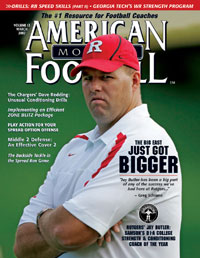AMERICAN FOOTBALL MONTHLY THE #1 RESOURCE FOR FOOTBALL COACHES
Article CategoriesAFM Magazine
|
Running Backs: Speed Skills Can be Taught - Part IIThe Speed Reportby: Dale Baskett Football Speed Specialist © More from this issue As previously discussed in part one of our article on running back speed, natural gifts are what we would all like to have at our fingertips. The reality is the resource per school doesn’t always match the desire for golden talent. When rubber meets the road, year to year we must be able to develop certain athletes who can perform at a consistant level coming out of the backfield. I am a huge believer that when working with youth you can develop the talent level with any program. The problem with the desirous ones who see the natural wonder is that they sometimes fall short of learning to identify and develop the qualities of the athletes in the fold. The key to development is having an open attitude towards the “potential of an athlete” and inspiring him to believe in what can be done skill-wise with work and consistant technical applica....The full article can only be seen by subscribers. Subscribe today!
|
|
|||||||
| HOME |
MAGAZINE |
SUBSCRIBE | ONLINE COLUMNISTS | COACHING VIDEOS |
Copyright 2025, AmericanFootballMonthly.com
All Rights Reserved





